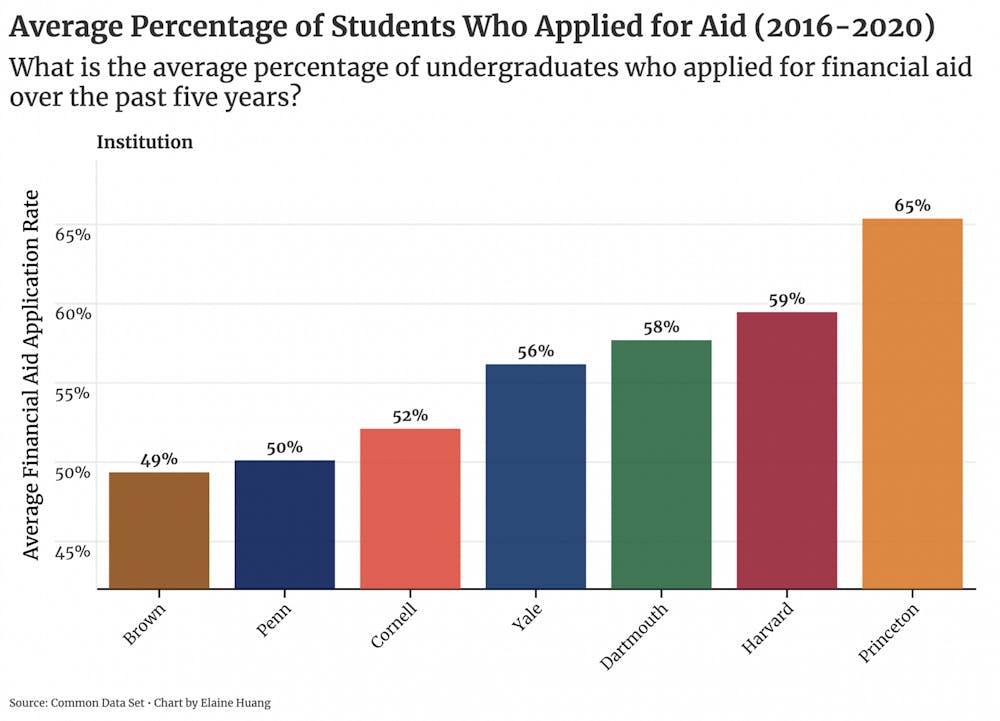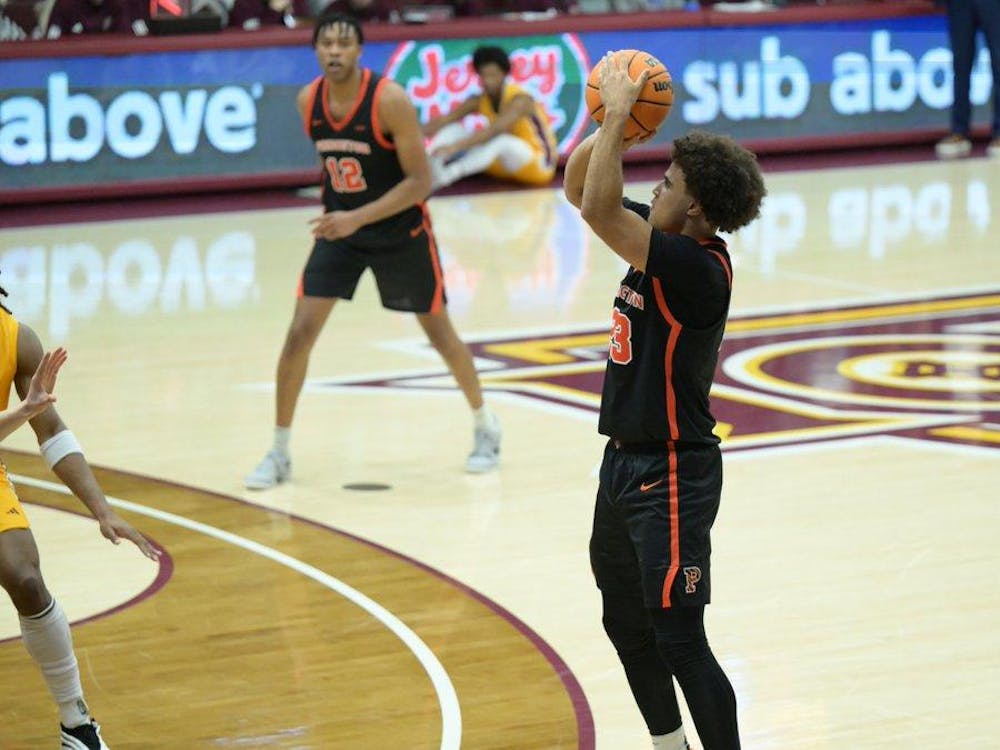In the 2000–2001 academic year, it cost $35,072 to attend Princeton. That year, the University’s average financial aid package equaled $21,909, roughly 62 percent of the total cost of attendance. In the decades since, increasing generosity has accompanied increasing costs.
While tuition, room, and board amounted to $69,020 in the 2019-2020 academic year, the average financial aid package has also increased dramatically, rising to $59,389 — approximately 86 percent of the total costs. This trend regarding significant growth in both college prices and financial aid packages has been mirrored across the Ivy League.
Utilizing data from the Common Data Set (CDS), a collaborative data-sharing project among institutions of higher education, The Daily Princetonian analyzed trends in financial aid across the Ivy League. While Columbia University does not participate in the CDS, the ‘Prince’ gathered data from the seven other Ivy League schools: Princeton, Brown University, Cornell University, Dartmouth College, Harvard University, the University of Pennsylvania (Penn), and Yale University.
Due to inconsistencies and gaps in the CDS, the ‘Prince’ was, at times, limited in its ability to collect data on financial aid. Data available in the CDS from Cornell began in 1999, Princeton in 2001, Dartmouth in 2003, Brown in 2004, Yale in 2005, Harvard in 2007, and Penn in 2009. As financial aid programs have almost uniformly grown more generous in recent years, schools that report older data may erroneously appear less generous than their peers.
While the percentage of undergraduates who apply for financial aid through their respective universities has varied greatly since the early 2000s, recent years have brought greater stability. Since 2009, the percentage of undergraduates at Princeton who applied for financial aid has remained between 62 and 66 percent.
Other Ivies have experienced similarly small fluctuations in the percentage of students applying for aid during the past five years. At Cornell, Dartmouth, Harvard, and Penn, the percentage of undergraduates who applied for aid never experienced a year-to-year fluctuation greater than three percent. Brown and Yale never exceeded a seven percent year-to-year fluctuation.
In order to better understand financial aid in the Ivy League, the ‘Prince’ spoke with former University President Shirley Tilghman. Tilghman led Nassau Hall from 2001 to 2013, notably guiding the University through the 2008 financial crisis.
Tilghman believes the small year-to-year fluctuations in the percentage of students who apply for aid has a simple explanation.
“The reason why it just stayed there probably has more to do with the demographics of the applicant pool than anything else,” she told the ‘Prince.’ “Thirty to 35 percent of the student body or the applicant pool are individuals who come from families who don't need financial aid.”
While this number, by Ivy League standards, is rather low, Princeton students disproportionately hail from wealthy backgrounds. According to a 2017 article from The New York Times, 72 percent of Princeton students come from families that make $110,000 or more per year, the top quintile of income. Conversely, 2.2 percent of Princeton students come from families who make $20,000 or less per year, the bottom quintile.

In recent years, a greater proportion of students at Princeton have applied for financial aid than at any other school that the ‘Prince’ examined.
On average, between 2016 and 2020, an average of 65 percent of undergraduates have applied for aid at Princeton each year, beating out the next closest school, Harvard, by six percent.
But not every student who applies for aid receives it. All the Ivies outwardly take pride in meeting 100 percent of demonstrated financial need, although “100 percent of demonstrated need” is a subjective standard, which the universities themselves determine.
The schools that the ‘Prince’ looked at overwhelmingly granted financial aid to those who applied. Each year, almost every school provided financial aid to over 80 percent of aid applicants, with only a single data point — Penn in 2011 — dipping below that metric.
During the period for which data is available, Yale awarded aid at the highest rate, granting money to an average of 93 percent of students who requested it, and Dartmouth awarded aid at the lowest rate, giving assistance to an average of 87 percent of those who asked.
“I think the financial aid office is taking a holistic view, toward the ability of a student and the student’s family to be able to contribute to their education,” Tilghman said, reflecting on Princeton’s process. “They take into account a great deal more than income. They take into account things like homeownership, how many children are in the family, how many of those children are actually in college at any one time, as well as other assets that the family may have that could help contribute to the cost of college.”
The process that Tilghman described, however, can create tricky incentives for students, according to Anya Miller ’25.
“The financial aid system is nice because it is designed to help students when something bad happens,” Miller said. “However, it does not help with positive change. For my case, if my single parent remarries, that adds to our income and becomes a loss for me financial aid-wise, which creates tension and makes it so that things that should be good in life are actually very terrible things for your financial aid.”
Almost every year, schools set new records with their price tags. As total cost has increased in the last two decades, so too has financial aid.
“The financial aid cost of attendance is adjusted annually to reflect changes in college costs,” explained Deputy University Spokesperson Michael Hotchkiss in an email to the ‘Prince.’
To more effectively compare the relationship between financial aid and total cost, the ‘Prince’ calculated the percentage of total cost covered by average financial aid packages.
Over time, all institutions have grown to cover a larger portion of the total cost of attendance. In 2019, Princeton covered the greatest fraction, the average aid package from the University covered 85 percent of the total cost for an individual student to enroll.
Tilghman said that the University took extra care during the 2008 financial crisis to ensure equity for low-income students.
“The only part of Princeton’s operating budget that was not cut in 2010 and 2011, during the worst years of the recession, was the financial aid budget,” she said, “which actually increased during those years, at a time when we were slashing our budgets left, right and center because of the decline in the value of the endowment.”
Princeton’s present comparative strength in this sphere often contributes to matriculation decisions.
“I probably would not have wanted to go if they didn’t offer financial aid,” said Delaan Nedd ’25. “I would not be as comfortable being here if I didn’t get the package that I did.”
Leia Walker ’22 agreed. “Princeton financial aid has been really liberating for me specifically because of study abroad,” explained the former head fellow of the Scholars Institute Fellows Program (SIFP), an organization that “provide[s] mentorship, programming, and support to first-generation and/or lower-income students.”
“I actually wouldn't be able to think about Princeton without thinking about study[ing] abroad,” she continued. “Knowing that Princeton is allowing its first-generation low-income students to also take part in these international conversations and expand their horizons has been a very beautiful and amazing thing for me.”
With an eye to the future, the upcoming financial aid cycle will reflect the continued impact of the COVID-19 pandemic, potentially upending recent trends.
“I do think it is important that you’re constantly reassessing what is reasonable to ask of the family,” Tilghman said. “I think there’s going to be a real reckoning in the next couple of years if inflation does not come back under control, because that's going to really change people’s sense of well-being.”
Elaine Huang is an Assistant Data Editor for The Daily Princetonian. She is a first-year concentrating in Operations Research and Financial Engineering (ORFE) and can be reached at eh0313@princeton.edu.








